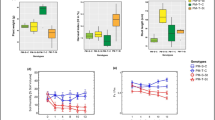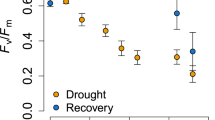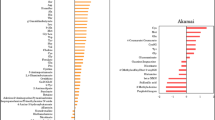Abstract
Aims
Root exudates of soybean grown under low-, normal-, and high-K+ conditions were evaluated using metabolomics.
Methods
Two soybean cultivars, ‘Satonohohoemi’ (low-K-tolerant) and ‘Tachinagaha’ (low-K sensitive), were hydroponically grown with 6 (K6), 60 (K60), and 120 (K120) mg K L−1 for 7 and 14 days after transplanting (DAT). Root exudates were collected, and metabolites were evaluated using capillary electrophoresis time-of-flight mass spectrometry.
Results
Rroot K concentration was lower in K6 and higher in K120 compared to K60. Number of metabolites detected in ‘Satonohohoemi’ and ‘Tachinagaha’ was 43 and 39, respectively. Score plot of the principal component analysis (PCA) showed a clear grouping of the root exudate metabolites based one three K concentrations and two sampling times, with the first PCA accounting for 65.7% and 71.5% of the variance for the ‘Satonohohoemi’ and ‘Tachinagaha’, respectively. High-K conditions enhanced release of root exudate metabolites to rhizosphere in both soybean cultivars from 18% to 42%. However, low-K conditions resulted in a 1.2-fold increase and a 2.5-fold decrease in the release of root exudate metabolites in ‘Tachinagaha’ and ‘Satonohohoemi’, respectively, at 7 and 14 DAT.
Conclusions
These results reveal that soybean roots exude many metabolites in response to high- and low-K conditions. The number of increased metabolites was higher after long-term (14 DAT) compared to that of the short-term (7 DAT) of exposure of high- and low-K conditions. Soybean cultivars differ in the capacity to release metabolites by altering the exudation of specific metabolites for a better adaptation to the high- and low-K conditions.




Similar content being viewed by others
Abbreviations
- DAT:
-
Days After Transplanting
- CE-TOF MS:
-
Capillary Electrophoresis Time-Of-Flight Mass Spectrometry
- PCA:
-
Principal Component Analysis
- K:
-
Potassium
- GlcNAc:
-
N-Acetylglucosamine
- JA:
-
Jasmonic Acid
- AICAR:
-
5-aminoimidazole-4-carboxamide-1-β-D-ribofuranoside
References
Arias-Barrau E, Olivera ER, Luengo JM, Fernandez C, GalanB GJL, Diaz E, Minambres B (2004) The homogentisate pathway: a central catabolic pathway involved in the degradation of L-phenylalanine, L-tyrosine, and 3-hydroxyphenylacetate in Pseudomonas putida. J Bacteriol 186:5062–5077
Baluška F, Mancuso S (2013) Root apex transition zone as oscillatory zone. Front Plant Sci 4:354
Basak BB, Biswas DR (2009) Influence of potassium solubilizing microorganism (Bacillus mucilaginosus) and waste mica on potassium uptake dynamics by Sudan grass (Sorghum vulgare Pers) grown under two alfisols. Plant Soil 317(1–2):235–255
Cakmak I, Hengeler C, Marschner H (1994) Partitioning of shoot and root dry matter and carbohydrates in bean plants suffering from phosphorus, potassium and magnesium deficiency. J Exp Bot 45:1245–1250
Canarini A, Kaiser C, Merchant A, Richter A, Wanek W (2019) Root exudation of primary metabolites: mechanisms and their roles in plant responses to environmental stimuli. Front Plant Sci 10:157
Carvalhais LC, Dennis PG, Fedoseyenko D, Hajirezaei MR, Borriss R, von Wiren N (2011) Root exudation of sugars, amino acids, and organic acids by maize as affected by nitrogen, phosphorus, potassium, and iron deficiency. J Plant Nutr Soil Sci 174:3–11
Chen D, Shao Q, Yin L, Younis A, Zheng B (2018) Polyamine function in plants: metabolism, regulation on development, and roles in abiotic stress responses. Front Plant Sci 9:1945
Dei HK (2011) Soybean as a Feed Ingredient for Livestock and Poultry, Recent Trends for Enhancing the Diversity and Quality of Soybean Products, Prof Dora Krezhova (Ed), ISBN: 978–953–307-533-4, InTech, Available from: https://www.intechopen.com/books/recent-trends-for-enhancing-the-diversity-and-quality-of-soybean-products/soybean-as-a-feed-ingredient-forlivestock-and-poultry
Fariduddin Q, Varshney P, Yusuf M, Ahmad A (2013) Polyamines: potent modulators of plant responses to stress. J Plant Interact 8(1):1–16
Gan YB, Stulen I, van Keulen H, Kuiper PJC (2002) Physiological changes in soybean (Glycine max) Wuyin9 in response to N and P nutrition. Ann Appl Biol 140(3):319–329
Glick BR (2012) Plant growth-promoting Bacteria: mechanisms and applications. Scientifica:963401
Grayston SJ, Vaughan D, Jones D (1977) Rhizosphere carbon flow in trees, in comparison with annual plants: the importance of root exudation and its impact on microbial activity and nutrient availability. Appl Soil Ecol 5(1):29–56
Häusler RE, Ludewig F, Krueger S (2014) Amino acids – a life between metabolism and signaling. Plant Sci 229:225–237
Huang XF, Chaparro JM, Reardon KF, Zhang R, Shen Q, Vivanco JM (2014) Rhizosphere interactions: root exudates, microbes, and microbial communities. Botany 92:267–275
Hussein HA, Mekki BB, El-Sadek MEA, Lateef EEE (2019) Effect of L-ornithine application on improving drought tolerance in sugar beet plants. Heliyon 5:e02631
Khan MA, Gemenet DC, Villordon A (2016) Root system architecture and abiotic stress tolerance: current knowledge in root and tuber crops. Front Plant Sci 7:1584
Khanghahi MY, Pirdashti H, Rahimian H, Nematzadeh G, Sepanlou MG (2017) Potassium solubilising bacteria (KSB) isolated from rice paddy soil: from isolation, identification to K use efficiency. Symbiosis 76:13–23. https://doi.org/10.1007/s13199-017-0533-0
Lacerda JJ, Lopes LO, Rambo TP, Marafon G, Silva AO, Lira DNS, Hickmann C, Dias KGL, Bottan AJ (2017) Soybean yield responses to micronutrient fertilizers Soybean - The Basis of Yield, Biomass and Productivity, Minobu Kasai, IntechOpen, Available from: https://www.intechopen.com/books/soybean-the-basis-of-yield-biomass-and-productivity/soybean-yield-responses-to-micronutrient-fertilizers
Li G, Wu Y, Liu G, Xiao X, Wang P, Gao T, Xu M, Han Q, Wang Y, Guo T, Kang G (2017) Large-scale proteomics combined with transgenic experiments demonstrates an important role of jasmonic acid in potassium deficiency response in wheat and rice. Molec Cell Proteomic 16(11):1889–1905
Li LY, Feng CX, Zhang YD (2019) Influence of collection time on the determination of root exudates in Fraxinus mandshurica by the metabolomics method. Appl Ecol Environ Res 17(4):9529–9545
Liu K, Xu Y, Zhou NY (2015) Identification of a specific maleate hydratase in the direct hydrolysis route of the gentisate pathway. Appl Environ Microbiol 81(17):5753–5760
Lucini L, Colla G, Moreno MBM, Bernardo L, Cardarelli M, Terzi V, Bonini P, Rouphael Y (2019) Inoculation of Rhizoglomus irregulare or Trichoderma atroviride differentially modulates metabolite profiling of wheat root exudates. Phytochemistry 157:158–167
Ma JF, Ryan PR, Delhaize E (2001) Aluminium tolerance in plants and the complexing role organic acids. Trends Plans Sci 6:273–278
Marschner H, Cakmak I (1989) High light intensity enhances chlorosis and necrosis in leaves of zinc, potassium, and magnesium deficient bean (Phaseolus vulgaris) plants. J Plant Physiol 134:308–315
McGrath C, Wright D, Mallarino AP, Lenssen AW (2013) Soybean Nutrient Needs Agriculture and Environment Extension Publications 189 Available from: https://core.ac.uk/download/pdf/38895581.pdf
Meena SV, Maurya BR, Meena SK, Mishra PK, Bisht JK, Pattanayak A (2018) Potassium solubilization: Strategies to mitigate potassium deficiency in agricultural soils. GJBAHS 7:3
Meier S, Alvear M, Borie F, Aguilera P, Ginocchio R, Cornejo P (2012) Influence of copper on root exudate patterns in some metallophytes and agricultural plants. Ecotoxicol Environ Saf 75:8–15
Mendez V, Agullo L, Gonzalez M, Seeger M (2011) The homogentisate and homoprotocatechuate central pathways are involved in 3- and 4-hydroxyphenylacetate degradation by Burkholderia xenovorans LB400. PLoS One 6:e17583
Moe LA (2013) Amino acids in the rhizosphere: from plant to microbes. Am J Bot 100(9):1692–1705
Monton MRN, Soga T (2007) Metabolome analysis by capillary electrophoresis-mass spectrometry. J Chromatogr A 1168(1–2):237–246
Mora ML, Rosas A, Ribera A, Rengel Z (2009) Differential tolerance to Mn toxicity in perennial ryegrass genotypes: involvement of antioxidative enzymes and root exudation of carboxylates. Plant Soil 320:79–89
Nadal M, Sawers R, Naseem S, Bassin B, Kulicke C, Sharman A, An G, An K, Ahern KR, Romag A, Brutnell TP, Gutjahr C, Geldner N, Roux C, Martinoia E, Konopka JB, Paszkowski U (2017) An N-acetylglucosamine transporter required for arbuscular mycorrhizal symbioses in rice and maize. Nat Plants 26(3):17073
Oburger E, Gruber B, Schindlegger Y, Schenkeveld WDC, Hann S, Kraemer SM, Wenzel WW, Puschenreiter M (2014) Root exudation of phytosiderophores from soil-grown wheat. New Phytol 203(4):1161–1174
Ohlrogge AJ (1960) Mineral nutrition of soybeans. Adv Agron 12:229–263
Oikawa A, Fujita N, Horie R, Saito K, Tawaraya K (2011) Solid-phase extraction for metabolomic analysis of high-salinity samples by capillary electrophoresis-mass spectrometry. J Sep Sci 34:1063–1068
Pettigrew WT (2008) Potassium influences on yield and quality production for maize, wheat, soybean and cotton. Physiol Plant 133:670–681
Pieterse CMJ, Zamioudis C, Berendsen RL, Weller DM, Van Wees SCM, Bakker PAHM (2014) Induced systemic resistance by beneficial microbes. Annu Rev Phytopathol 52:347–375
Prajapati K, Sharma MC, Modi HA (2013) Growth promoting effect of potassium solubilizing microorganism on OKRA (Abelmoscus Esculantus). Int J Agric Sci 3(1):181–188
Ramos-Gonzalez MI, Campos MJ, Ramos JL (2005) Analysis of Pseudomonas putida KT2440 gene expression in the maize rhizosphere: in vivo expression technology capture and identification of root-activated promoters. J Bacteriol 187:4033–4041
Reuter DJ, Robinson JB (1997) Plant analysis: an interpretation manual. CSIRO Australia
Römheld V, Kirkby EA (2010) Research on potassium in agriculture: needs and prospects. Plant Soil 335:155–180
Rovira AD (1969) Plant root exudates. Bot Rev 35:35–59
Rudder KEE, Sohlenkamp C, Geiger O (1999) Plant-exuded choline is used for rhizobial membrane lipid biosynthesis by phosphatidylcholine synthase. J Biol Chem 274(28):20011–20016
Sale PWG, Campbell LC (1986) Yield and composition of soybean seed as a function of potassium supply. Plant Soil 96:317–325
Samal D, Kovar JL, Steingrobe B, Sadana US, Bhadoria PS, Classen N (2010) Potassium uptake efficiency and dynamics in the rhizosphere of maize (Zea mays L), wheat (Triticum aestivum L), and sugar beet (Beta vulgaris L) evaluated with a mechanistic model. Plant Soil 332:105–121
Schmid NB, Giehl RF, Doll S, Mock HP, Strehmel N, Scheel D, Kong X, Hider RC, von Wiren N (2014) Ferulolyl-CoA 6'-Hydroxylase1-dependent coumarins mediate iron acquisition from alkaline substrates in Arabidopsis. Plant Physiol 164:160–172
Singh SK, Reddy VR (2017) Potassium starvation limits soybean growth more than the photosynthetic processes across CO2 levels. Front Plant Sci 8:991
Smil V (1999) Crop residues: agriculture's largest harvest. Bioscience 49:299–308
Sugimoto M, Hirayama A, Ishikawa T, Robert M, Baran R, Uehara K, Kawai K, Soga T, Tomita M (2010a) Differential metabolomics software for capillary electrophoresis-mass spectrometry data analysis. Metabolomics 6:27–41
Sugimoto M, Koseki T, Hirayama A, Abe S, Sano T, Tomita M, Soga T (2010b) Correlation between sensory evaluation scores of Japanese sake and metabolome profiles. J Agric Food Chem 58:374–383
Sugimoto M, Wong DT, Hirayama A, Soga T, Tomita M (2010c) Capillary electrophoresis mass spectrometry-based saliva metabolomics identified oral, breast and pancreatic cancer-specific profiles. Metabolomics 6:78–95
Sung J, Lee S, Lee Y, Ha S, Song B, Kim T, Waters BM, Krishnan HB (2015) Metabolomic profiling from leaves and roots of tomato (Solanum lycopersicum L) plants grown under nitrogen, phosphorus or potassium-deficient condition. Plant Sci 241:55–64
Tawaraya K, Horie R, Saito S, Wagatsuma T, Saito K, Oikawa A (2014a) Metabolite profiling of root exudates of common bean under phosphorus deficiency. Metabolites 4:599–611
Tawaraya K, Horie R, Shinano T, Wagatsuma T, Saito K, Oikawa A (2014b) Metabolite profiling of soybean root exudates under phosphorus deficiency. Soil Sci Plant Nutr 60:679–694
Trehan SP, Claassen N (1998) External K requirement of young plants of potato, sugar beet and wheat in flowing solution culture resulting from different internal requirements and uptake efficiency. Potato Res 41:229–237
United States Department of Agriculture (USDA) (2019) World Agricultural Production Page 27 Available from: https://apps.fas.usda.gov/PSDOnline/Circulars/2019/10/production.pdf
Wagatsuma T, Kawashima T, Tawaraya K (1998) Comparative stainability of plant root cells with basic dye (methylene blue) in association with alumunium tolerance. Common Soil Sci Plan Anal 19:1207–1215
Wang Y, Lambers H (2020) Root-released organic anions in response to low phosphorus availability: recent progress, challenges and future perspectives. Plant Soil 447:135–156
Watanabe M, Kusano M, Oikawa A, Fukushima A, Noji M, Saito K (2008) Physiological roles of the beta-substituted alanine synthase gene family in Arabidopsis. Plant Physiol 146:310–320
Xu WH, Liu H, Ma QF, Xiong ZT (2007) Root exudates, rhizosphere Zn fractions, and Zn accumulation of ryegrass at different soil Zn levels. Pedosphere 17(3):389–396
Zhang C, Kong F (2014) Isolation and identification of potassium-solubilizing bacteria from tobacco rhizospheric soil and their effect on tobacco plants. Appl Soil Ecol 82:18–25
Zhang A, Zhao G, Gao T, Wang W, Li J, Zhang S (2013) Solubilization of insoluble potassium and phosphate by Paenibacillus kribensis a soil microorganism with biological control potential. Afr J Microbiol Res 7(1):41–47
Zipfel C, Oldroyd GED (2017) Plant signalling in symbiosis and immunity. Nature 543:328–336
Zorb C, Senbayramb M, Peiterc E (2013) Potassium in agriculture - status and perspectives. J Plant Physiol 171(9):656–669
Acknowledgements
This study was supported by Grants-in-Aid for Scientific Research (No. 15H02438 and 19H01169) from the Japan Society for the Promotion of Science (JSPS).
Author information
Authors and Affiliations
Contributions
Tantriani, KT, TS, AO designed the study and performed the experiments. Tantriani, KT, TS, WC, KS, AO, and BH analyzed the data. Tantriani and KT wrote the manuscript. All authors read and approved the final manuscript.
Corresponding author
Ethics declarations
Conflict of interest
The authors declare that they have no conflict of interest.
Research involved human and animal participants
This article does not contain any studies with human and/or animal participants performed by any of the authors.
Additional information
Responsible Editor: Terry James Rose.
Publisher’s note
Springer Nature remains neutral with regard to jurisdictional claims in published maps and institutional affiliations.
Electronic supplementary material
ESM 1
(DOCX 187 kb)
Rights and permissions
About this article
Cite this article
Tantriani, Shinano, T., Cheng, W. et al. Metabolomic analysis of night-released soybean root exudates under high- and low-K conditions. Plant Soil 456, 259–276 (2020). https://doi.org/10.1007/s11104-020-04715-w
Received:
Accepted:
Published:
Issue Date:
DOI: https://doi.org/10.1007/s11104-020-04715-w




